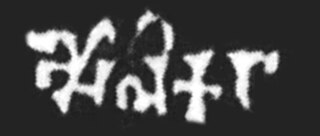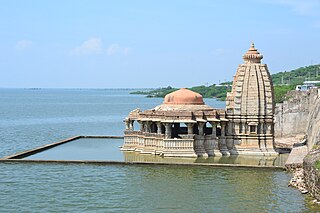Related Research Articles
Gumla is a city which is the district headquarters in the Gumla subdivision of the Gumla district in the state of Jharkhand, India.
Vikram Samvat or Bikram Sambat and also known as the Vikrami calendar, is a historical calendar used in the Indian subcontinent. Vikram Samvat is generally 57 years ahead of Gregorian Calendar, except during January to April, when it is ahead by 56 years. Alongside Nepal Sambat, it is one of the two official calendars used in Nepal. In India, it is used in several states. The traditional Vikram Samvat calendar, as used in India, uses lunar months and solar sidereal years. The Nepali Bikram Sambat introduced in 1901 CE, also uses a solar sidereal year.

Chanderi, is a town of historical importance in Ashoknagar District of the state Madhya Pradesh in India. It is situated at a distance of 127 km from Shivpuri, 37 km from Lalitpur, 55 km from Ashok Nagar and about 46 km from Isagarh. It is surrounded by hills southwest of the Betwa River. Chanderi is surrounded by hills, lakes and forests and is spotted with several monuments of the Bundela Rajputs and Malwa sultans. It is famous for ancient Jain Temples. Its population in 2011 was 33,081.
Wadhwan, also spelled Vadhwan, is a city and a municipality in Surendranagar district in the Indian state of Gujarat. Located on the banks of the Bhogavo River, around 3 km from Surendranagar and 111 km from Ahmedabad, Wadhwan is a known location for its old world royal charm and serene space with a life and culture of its own. It was historically the capital of Wadhwan State.

Gumla district is one of the twenty-four districts of Jharkhand state, India, and Gumla town is the administrative headquarters of this district.

Shankheshwar is a town in the Patan district of Gujarat state of India. It is an important place of pilgrimage for the followers of Jainism.
Bamnera(बामनेरा) is a small village situated along the inner margin of the southwestern part of the Thar Desert in the foothills of Aravali mountain range with panoramic landscapes and a few sandy tracks. In more urban geographical terms, it is situated in the Sumerpur tehsil of Pali District in the state of Rajasthan, 12.5 km west of Sheoganj-Sirohi District from Beawar-Radhanpur NH 14.

The Aulikaras, also referred to as Aulikara dynasty or Olikara dynasty, were an ancient Indian clan from the Maurya era, that emerged into a kingdom between the 4th-century CE and 6th-century CE. They were based in the Malwa (Malawa) region of central India near Mandsaur, with their power center near what is now western Madhya Pradesh, southeastern Rajasthan and northeastern Gujarat. Two royal houses belonging to this clan ruled over the present-day western Malwa region of Madhya Pradesh state from c. 350 CE to 550 CE, much of it as feudatories of the Gupta Empire.
Kharwar is a community found in the Indian states of Uttar Pradesh, Bihar, Jharkhand, Chhattisgarh, Orissa and West Bengal.

Nagpuri is an Indo-Aryan language spoken in the Indian states of Jharkhand, Chhattisgarh, Odisha and Bihar. It is primarily spoken in the west and central Chota Nagpur plateau region.

The Nagvanshis of Chotanagpur, was an ancient Indian dynasty which ruled the parts of Chota Nagpur plateau region during much of ancient, medieval and modern period. Phani Mukut Rai is considered the first king of dynasty claim to be son of Pundrika Naga a mythical Naga. Lal Chintamani Sharan Nath Shahdeo (1931–2014) was last ruling king of the dynasty, until the estate was merged to the Republic of India.

Bisaldeo temple, also known as Bisaldev temple or Bisal Deoji's temple, is a Hindu temple in Bisalpur, India. It is located beside the Bisalpur Dam on the Banas River, in the Tonk district of Rajasthan state. The temple is dedicated to Gokarneshvara, an aspect of Shiva. A Monument of National Importance, it was commissioned by the 12th century Chahamana ruler Vigraharaja IV, who is also known as Bisal Deo.
Nagpuria people, historically referred to as Sadan, are an Indo-Aryan ethnolinguistic group who are the traditional speaker of Nagpuri language and native of western Chota Nagpur Plateau region of Indian state Jharkhand, Chhattisgarh and Odisha.
Raghunath Shah was a Nagvanshi king in the 17th century. He succeeded Durjan Sal in 1640. His capital was at Navratangarh. He built several temples during his reign.
Bhim Karn was Nagvanshi king in 12th century. He succeeded Gandharv Rai. The change of title of Nagvanshi kings from Rai to Karn may be due to victory over or alliance with descedant of Lakshmikarna of Kalachuri dynasty.
The Khayaravala dynasty, was a dynasty, that ruled parts of the present-day Indian states of Bihar and Jharkhand, during the 11th and 12th centuries. Their capital was located at Khayaragarh in Shahabad district. Pratapdhavala and Shri Pratapa were kings of the dynasty according to inscription of Rohtas. The dynasty ruled the Japila territory(now Japla) as feudatories, of the Gahadavalas.
Pratapdhavala was Khayaravala king in 12th century. There are inscription of Pratapdhavala in Phulwaria, Tutrahi fall rock inscription of Vikram Samvat 1214, Tarachandi rock inscription of Vikram Samvat 1225.
Shri Pratapa was Khayaravala king in 13th century. There are inscription of Shri Pratapa in Rohtas of Vikram Samvat 1279. According to inscription he defeated a "Yavana" army; the "Yavana" here probably refers to a Muslim general. According to the inscription of Rohtas Fort, Shri Pratapa was descendant and successor of Pratapdhavala.
Ram Shah was Nagvanshi king in 17th century. His capital was at Navratangarh. He succeed Raghunath Shah and ruled from 1690 to 1715 CE.
Gajghat Rai was Nagvanshi king in 9th century. He succeeded Gajdant Rai.
References
- ↑ "Hapamuni". gumla.nic.in. Retrieved 22 December 2019.
- ↑ Jharkhand Encyclopedia Hulgulanon Ki Partidhwaniyan-1 . Retrieved 22 December 2019.
- ↑ Ranjan, Manish (19 August 2002). Jharkhand Samanya Gyan. ISBN 9789351867982 . Retrieved 22 December 2019.
- ↑ "The Supreme Personality of Godhead at Hapamuni". Radha.name. 2 September 2019.
- ↑ "1100 years old Maa Mahamaya Temple is located in Gumla district, know what is the story behind its establishment". newsncr. 8 October 2021. Retrieved 17 August 2022.